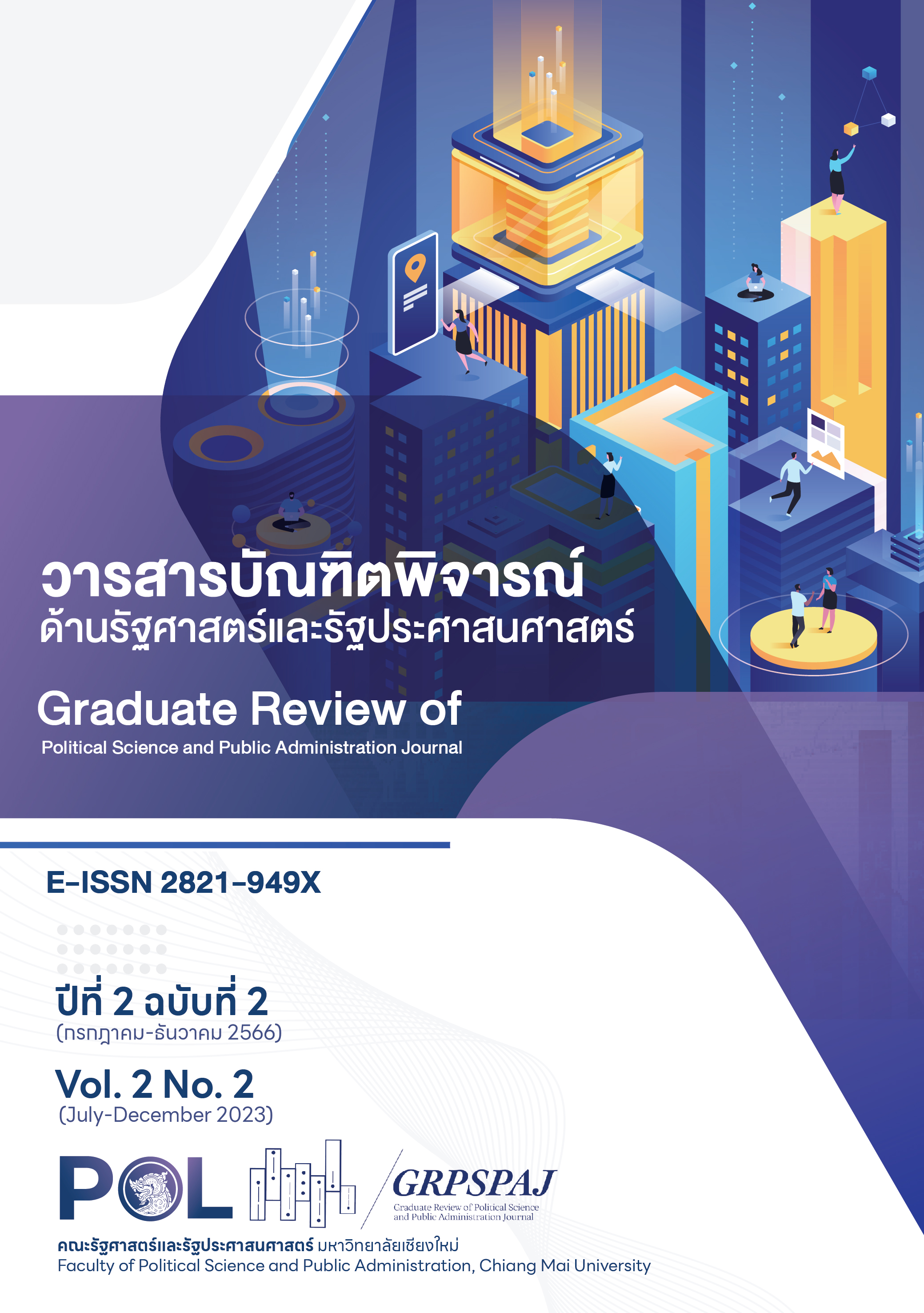Development Innovation: Comparison of Digital Government Pathways in Estonia and Thailand
Main Article Content
Abstract
The three objectives of this article were 1) to conduct a comparative study of Estonia's approach to digital government development compared to Thailand, 2) to analyze the success of Estonia's digital government development approach, and 3) to suggest digital government development guidelines for Thailand. The main findings of this article were as follows. First, the process of development towards a digital government in the case of Estonia began to emerge in the early 1990s, with the government acting as the main driver of the development process. It was found that Estonia's digital government development process was divided into three phases, with Phase 1 comprising development-initiated states, Phase 2 comprising development states, and Phase 3 being developed states. Second, success in building and developing a digital government in the case of Estonia involved state-led development ideology and development networks playing a significant part in ensuring success in the process of creating and developing a digital government. Lastly, recommendations for Thailand's digital government development approach can be divided into 3 levels, including 1) the governmental level, which must play a leading role in the development of a digital government, incorporating the formulation of Thailand's digital government development plan by social conditions in the context of Thailand, 2) the network level, which requires building a network of governance from various sectors to drive Thailand's digital government development plan, and 3) the citizen level, at which digital citizenship is created through the education system to absorb and create so-called digital citizenship in line with Thailand's digital government development plan.
Article Details

This work is licensed under a Creative Commons Attribution-NonCommercial-NoDerivatives 4.0 International License.
Graduate Review of Political Science and Public Administration Journal is licensed under a Creative Commons Attribution-NonCommercial-NoDerivatives 4.0 International (CC BY-NC-ND 4.0) licence, unless otherwise stated. Please read our Policies page for more information...
References
กุลธน ธนาพงศธร. (2536). อดีต ปัจจุบัน และอนาคตของรัฐประศาสนศาสตร์เปรียบเทียบ. ใน พิทยา บวรวัฒนา (บก.), รัฐประศาสนศาสตร์: รวมผลงานของนักวิชาการไทย (พิมพ์ครั้งที่ 2) (น. 121-140). สำนักพิมพ์แห่งจุฬาลงกรณ์มหาวิทยาลัย.
กุลลดา เกษบุญชู มี้ด. (2556). กระบวนการเข้าสู่ความเป็นสากลของระบบทุนนิยมและลัทธิเสรีนิยมใหม่. วารสารสังคมศาสตร์, 43(2), 7-43.
จิตติภัทร พูนขำ, และณัฐนันท์ คุณมาศ. (2556). ยุโรปกลางและตะวันออก: การหวนคืนสู่ยุโรปและการเข้าสู่เศรษฐกิจเสรี. ศูนย์ยุโรปศึกษาแห่งจุฬาลงกรณ์มหาวิทยาลัย.
ณัฐวีร์ พุ่มระชัฏร์, และปรีชญาณ์ นักฟ้อน. (2566, กรกฎาคม 22). กระบวนการพัฒนาและสร้างรัฐบาลดิจิทัล: กรณีศึกษาประเทศเอสโตเนีย [เอกสารนำเสนอในที่ประชุม]. การนำเสนอในงานประชุมวิชาการระดับชาติเครือข่ายการศึกษาวิจัยและความสัมพันธ์ทางวิชาการด้านรัฐศาสตร์และรัฐประศาสนศาสตร์ ครั้งที่ 7, โรงแรมพูลแมน ขอนแก่น ราชา ออคิด.
ติน ปรัชญพฤทธิ์. (2553). รัฐประศาสนศาสตร์ปรียบเทียบ เครื่องมือในการพัฒนาประเทศ. (พิมพ์ครั้งที่ 5). อินทภาษ.
ทิพวรรณ หล่อสุวรรณรัตน์. (2559). รัฐบาลอิเล็กทรอนิกส์ e-Government (พิมพ์ครั้งที่ 10). แซท โฟร์ พริ้นติ้ง.
นิธิ เนื่องจำนงค์. (2552). รัฐที่(ยังคง)ขับเคลื่อนการพัฒนา: พัฒนาการของคำอธิบายและประเด็นในการศึกษาวิจัย. วารสารเอเชียตะวันออกศึกษา, 13(2), 71-99.
เรวัต แสงสุริยา. (2560). บนเส้นทางการพัฒนารัฐบาลอิเล็กทรอนิกส์ในสังคมไทย: ยุคการปฏิรูประบบราชการ. วารสารวิชาการมนุษยศาสตร์และสังคมศาสตร์, 25(47), 43-64.
วศิน ปั้นทอง. (2563). เอสโตเนีย: ประชาธิปไตย เทคโนโลยีและความมั่นคงไซเบอร์. สำนักงานสัญญาธรรมศักดิ์ เพื่อประชาธิปไตย.
ส. ศิวรักษ์. (2565). แนวคิดปรัชญาการเมืองของเปลโตและอริสโตเติล. สยามปริทัศน์.
สำนักงานคณะกรรมการปฏิรูประบบราชการ. (2544). การปฏิรูประบบราชการ: รัฐบาลอิเล็กทรอนิกส์ (e-Government). ฟิสิกส์เซ็นเตอร์.
สำนักงานพัฒนารัฐบาลดิจิทัล. (2566). แผนพัฒนารัฐบาลดิจิทัลของประเทศไทย พ.ศ. 2566-2570. สำนักงานพัฒนารัฐบาลดิจิทัล.
อภิชาต สถิตนิรามัย. (2556). รัฐไทยกับการปฏิรูปเศรษฐกิจ: จากกำเนิดทุนนิยมนายธนาคารถึงวิกฤตเศรษฐกิจ 2540. ฟ้าเดียวกัน.
อัมพร ธำรงลักษณ์. (2565). ความโปร่งใส: แนวคิด แนวปฏิบัติ และประเด็นถกเถียง. ศูนย์วิจัยดิเรก ชัยนาม.
ไอริน โรจน์รักษ์. (2564). จาก Estonia สู่ E-Estonia: ถอดบทเรียน 30 ปี ธรรมาภิบาลกับการปฏิรูปภาครัฐ. วารสารมนุษศาสตร์และสังคมสาศาสตร์ นายเรืออากาศ. 9, 161-174.
Chundasutathanakul, S. (2020). Democracy, Developmental State and Neo-Authoritarianism. Journal of Public Administration and Politics, 9(1), 109-132.
Estonian Innovation Agency. (2022). e-Estonia Guide. e-estonia.com. https://e-estonia.com/wp-content/uploads/eestonia-vihik-a5-edm.pdf
Ingram, G., & Dooley, M. (2021). Digital Government: Foundations for Global Development and Democracy. Center for Sustainable Development at Brookings.
Kattel, R., & Mergel, I. (2019). Estonia’s Digital Transformation: Mission Mystique and the Hiding Hand. In M. E. Compton, & P. ‘T Hart, (Eds.), Great Policy Successes (pp. 143-160). Oxford University Press.
Steger, M. B., & Roy, R. K. (2010). Neoliberalism: A Very Short Introduction. Oxford: Oxford University Press.
Weiss, L. (2004). Guiding Globalisation in East Asia: New Roles for Old Developmental States. In L. Weiss, (Ed.), States in the Global Economy: Bringing Domestic Institutions Back In (pp. 245-270). Cambridge University Press.


